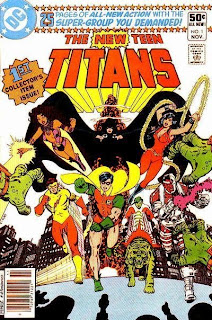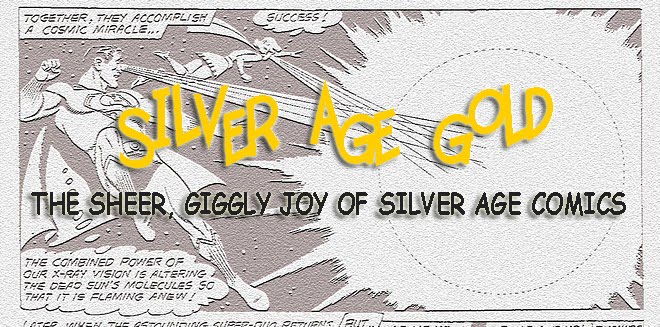
Okay kiddies, let me tell you all a story about how weird things can get when people care about a little something called "continuity". See, back in the 1940's, There were a LOT of superheroes. So many, in fact, that geeks in the 1960's and 70's-who had discovered the joy of collecting back issues of comic books- dubbed the 1940's the "Golden Age".
Among the alums of the Golden Age years were Superman, Batman and Robin, Wonder Woman,
Aquaman, Green Arrow, The Flash, Green Lantern, The Atom and
Hawkman, to name a relevant few. They all belonged to a club for superheroes, named the Justice Society of America. As time went on, some of these heroes fell out of fashion. The Atom and
Hawkman's back-up features were dropped, and The Green Lantern and The Flash had their titles cancelled.The Golden Age had drawn to a close.


By the early 1950's TV had stolen a lot of thunder from the comics. Dr. Frederick
Wertham launched a comic book smear campaign that made it all the way to a senate sub-committee hearing before Joe McCarthy convinced everyone that the Communists had infiltrated the Federal Government. Suddenly, the idea that comics books were the cause of juvenile delinquency seemed like small potatoes.
Superheroes were kind of left out in the cold. Westerns and romance comics carried a greater share of the market. It is sometimes said that only Superman, Batman and Wonder Woman survived. This is not exactly true. They were the only DC Heroes who kept their own titles. DC still had quite a few superheroes in the early 50's.
Aquaman and Green Arrow were still going strong as back-up features, guys like
Robotman and Johnny Quick were still around. In 1955, Martian
Manhunter quietly debuted in Detective Comics.
Then, in 1956 it happened. BIG.
DC's new editor, Julius Schwartz decided to add to their pantheon of superheroes, not by bringing back their cancelled characters, but by reinventing them. Calling on Golden Age writer Gardner Fox, DC reintroduced one of Fox's characters from the 40's, The Flash. The new Flash made his debut in
Showcase #4 and was an instant hit.

Soon, other characters were re-
invisioned;
Green Lantern,
Hawkman and the Atom were all brought back, this time with more Science-fiction back-grounds. Soon, even the old Justice Society of America had been resurrected. This time as the Justice LEAGUE of America. But what had happened to those older versions of the superheroes??



Well, in reality, nothing. However, Gardner Fox had planted a seed in Showcase #4 that sprung into something bigger and bigger as time went on. Fox and artist Carmine
Infantino had actually had The new Flash, Barry Allen reading issues of
Flash Comics which starred the Golden Age Flash, Jay Garrick. The discarded heroes of the 1940's had become the stuff of fiction-within-fiction.
Then, in
Flash #123 "The Flash of Two Worlds", something happened. Barry Allen, traveling fast enough to leave the bounds of his own dimension, stumbled into another world. A world where Jay Garrick was real. It turned out that, in Barry's reality (now
DC's main reality), comics writer Gardner Fox, who wrote the Flash Comics that inspired Barry Allen's superhero identity, was able to see another dimension in his dreams while he slept. Using the story ideas he got from his dreams, he had written about the Golden Age Flash, unaware that he was a real hero in another dimension. It seems that in the other dimension, which Barry dubbed "Earth Two",
DC's 1940's heroes were all alive and well, albeit middle-aged.
This opened a whole new can of worms. Now, there were two versions of Batman, Superman and Wonder Woman as well as an adult Robin. Suddenly, any stories written in the 1940's had actually happened on Earth Two. Soon, team-ups between the Justice League and the Justice Society became a regular event. Not long after, Earth Three was discovered- a terrible place where the Justice League were actually a gang of super-criminals called the Crime Syndicate who battled lone hero
Lex Luthor...



Honestly, it was a lot of fun. Problem is, everyone began to take keeping it all straight very seriously. By the 1980's, DC had so many versions of their characters floating around, they decided to do some house cleaning. But they didn't just cancel titles and stop writing about characters they didn't want anymore. No, this time they made it an event.
DC Released a huge, 12-issue mini-series called "Crisis on Infinite Earths" wherein an evil entity destroys every parallel dimension but one, leaving one shared reality for all the characters who survived. Neat idea. Except it still left a huge mess that has ramifications to this day. And, it wasn't long before most of the characters who had been killed off crept their way back in. They killed off
Supergirl... now there are like 4 of her.

When I was a freshman in college, some guy in my dorm was talking about comics. I was an avid Batman reader at the time and said something about the third Robin (who was still new) and he says "Actually, there are four Robins. There's the one from the 40's. " He was referring to the Earth Two Robin, who
technically was from the 60's. So I said, "well, he's STILL Dick Grayson, so I don't know if he would count. And didn't they get rid of that guy in 'CRISIS'?". Still, he persisted. Now, this was a dorky argument, and my point of view was no more valid than his (well, maybe a little...) but how far was I supposed to go with this? Did I have to acknowledge the Robin II from that one story in Batman where Robin grows up to be Batman II and Batman and Batwoman have a son who becomes Robin II? What about Carrie Kelly, the Girl Wonder from The Dark Knight Returns? Do Burt Ward and Casey Casem's voices constitute unique Robin entities??
No, kiddies. For me, continuity in comics is something that is best used when it suits you and ignored when it doesn't. And remember, the next time some sweaty
fanboy argues a point of continuity with you, just tell him "relax... it's a COMIC BOOK".














































